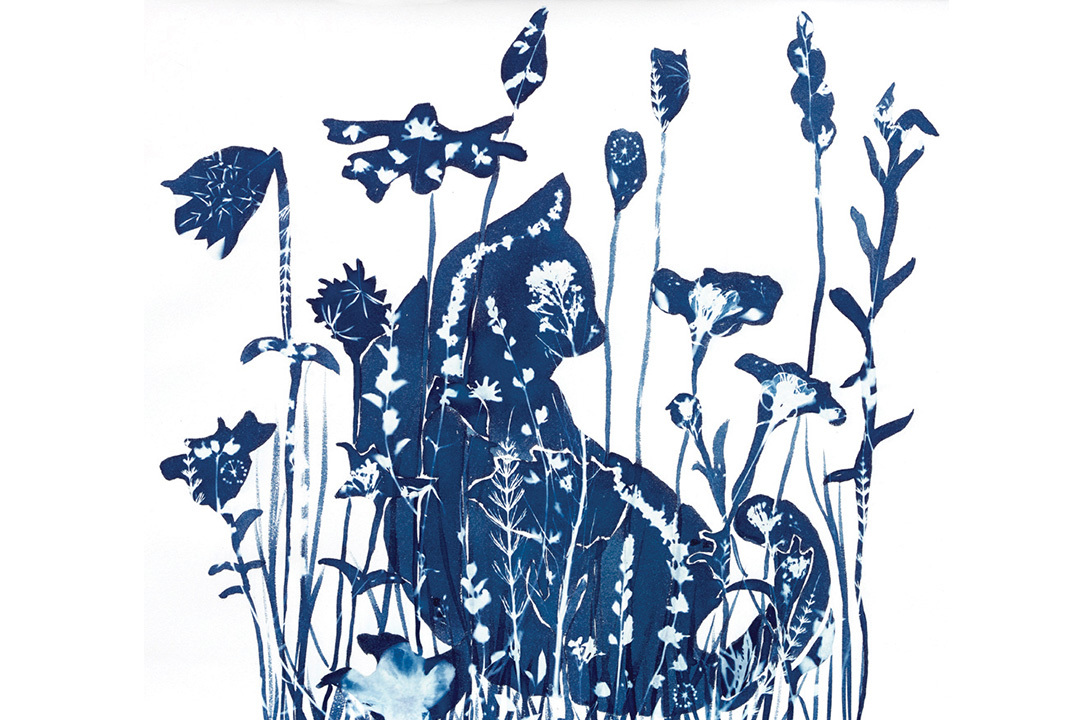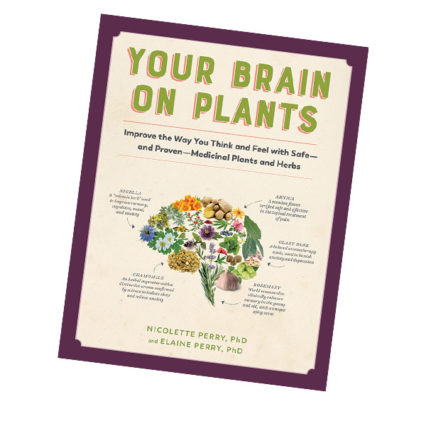8 Best Plants for Improving Memory & Concentration
Camouflage (process) - Brooke Sauer
These botanicals are nontoxic and can be taken with confidence.
Most of us over 60 will experience some sort of memory decline, with changes in cognitive function and brain structure. Retaining information and experience is a vital part of our identity and conscious awareness, and there are plants that science has shown can help in this. It was the science of “cognitive plants” that took our research on a new road and led to the creation of the Dilston Physic Garden in the wilds of Northumberland, England.
It has been 20 years since we first turned our attention to plants as promising aids in the treatment of memory loss and dementia. The common garden herb sage, best known for adding flavor to the stuffing when cooking poultry, surprised us. We included it in lab tests because of its long-standing reputation in old herbals for helping memory. In 1597, English herbalist John Gerard wrote in The Herball; or, Generall Historie of Plantes that sage was “singularly good for the head and brain; it quickeneth the sense and memory.” More than 400 years later, our research shows that sage (Salvia officinalis and S. lavandulaefolia) and other well-known household herbs such as lemon balm (Melissa officinalis) work on brain memory signals to improve memory, which we tested in the lab and in trials against placebo. Gerard was right.
Testing plants for use in cognition is now a thriving research area around the world. Since the early days of our research, the number of papers published on plants implicated in memory improvement has risen from under 20 to over 200 a year. The incentives are great—for example, the need for new therapies for Alzheimer’s disease, which affects so many in old age. And expectations are realistic, with two of today’s treatments based on drugs that come from plants. A drawback is that the plants providing these drugs (galantamine from snowdrops or daffodils, and rivastigmine from the Calabar bean) are highly toxic, which means side effects such as nausea are a problem. For this reason, we have picked out eight botanical brain balms for memory and concentration that are nontoxic, and you can be confident that their therapeutic effect is backed by hundreds of years of use, along with clear evidence from the lab and from tests on humans.
Chinese Club Moss
This traditional Chinese medicine for memory took the world by storm 50 years ago. Clinical studies show its ingredient huperzine is an effective cognitive enhancer that boosts learning, memory, and mood in students and people with Alzheimer’s, and it is safe to take. In China it is becoming endangered, but it also grows in tropical and subtropical forests of Australia and India.
HOW TO TAKE IT: Commonly taken in capsules or powder form, or in capsules of the active ingredient huperzine A on its own. Aerial parts (leaves and stems) can be taken as a tea or added to your morning smoothie. Not to be mistaken for Lycopodium clavatum (a related species that does not contain the active ingredient huperzine). Consult your health care practitioner, since dosage can vary with health, age, and weight. To avoid side effects such as blurred vision, nausea, and vomiting, do not exceed recommended dose. Do not take during pregnancy, or if you have hypertension, epilepsy, pulmonary disorders, or heart conditions. (It can change the heart rate.)
Bacopa
This succulent swamp plant used in Ayurvedic medicine is increasingly being recognized for its effects on memory. Subject to hundreds of scientific research studies in Australia and India, it has memory, antiaging, and brain-health properties, and it also shows positive results for attention deficit hyperactivity disorder (ADHD) in children.
HOW TO TAKE IT: Studies show that fresh aerial parts (leaves and stems, up to 10 g daily) are best to use and can be made into pesto or dal. When dried and stored (for no longer than three months), it can be made into a paste, tincture, or tea. Also available as capsules and tablets. May require up to 12 weeks for cognitive effects, but anxiety-relieving effects are more immediate. Take with food but not on a full stomach, since it may cause indigestion. Use caution with antidepressant, sedative, and thyroid medication.
Sage
European sage (Salvia officinalis) is extolled for so many virtues relating to the well-being of mind and body that it’s considered a cure-all in Europe. Our original research on sage—driven by its centuries-old reputation for enhancing memory—seeded the idea for Dilston Physic Garden. In controlled trials, sage enhances memory and alertness in healthy people—both younger and older. It also improves attention in the elderly, countering cognitive impairment as well as improving behavioral measures in Alzheimer’s. Mood improvement has been measured by calmness and contentedness in volunteers.
HOW TO TAKE IT: Teas made from leaves—fresh (20 g) or dried (4 to 6 g), per 240 ml water—three times daily; particularly good with honey. Capsules, tablets, tinctures, sprays (water extracts for throat infections), and culinary preparations are also used—such as in classic poultry stuffing or fried on its own—but effective medicinal doses may not be reached without regular consumption. The ingredient thujone (in S. officinalis) makes it unsuitable for children, pregnant women, or those with epilepsy. Both species contain camphor. Consult your physician if you take medications for high blood pressure or diabetes (S. officinalis clinically lowers blood sugar), or if you have hormone-sensitive conditions (sage is estrogenic).
Nigella
Described as the Ayurvedic “miracle herb,” nigella has an extraordinary range of health benefits, and many of them are backed by science. In controlled clinical studies, nigella enhanced cognition and verbal learning as well as mood, and it relieved anxiety in healthy males.
HOW TO TAKE IT: Dried seeds (2 to 3 g daily, though it can be used liberally as a foodstuff); dry-roast to bring out flavor and remove any bitterness. Use in curries, salads, breads (maybe add honey), oils, and in the spice mix panch phoron (delicious when added to boiling rice). Also available in capsules and as seed powder or oil. All clinical trials report safety, although contact dermatitis and lowered blood pressure have been reported as side effects.
Rosemary
Renowned for being the best herb for memory, both for enhancing personal memory function and as a symbol of remembrance. Clinical studies show that rosemary extract strengthens attention and memory in healthy students, adults, and the elderly. Used with lemon, orange, and lavender, it improves cognitive function in people with Alzheimer’s. Research at Northumbria University in England has shown that the essential oil helps improve memory by 15 percent in those over age 65, and it strengthens recall of events in the future (remembering to remember) by 70 percent.
HOW TO TAKE IT: Tea made from leaves and flowers—fresh (4 to 6 g) and dried (2 to 3 g), per 240 ml water—three times daily. Tinctures, capsules, and essential oils in aromatherapy are also used. Rosemary is an essential ingredient in many culinary dishes; it makes an excellent oil infusion for cooking. Considered safe at the recommended dose during pregnancy, but not in epilepsy.

Camouflage Brooke Sauer
Peppermint
No other herb currently has such convincing evidence for combined body and mind usage. With its robust reputation as an antispasmodic remedy in modern mainstream medical practice, the science is only just being discovered behind peppermint’s longtime traditional use for boosting memory and alertness. Unlike prescription drugs for cognition, peppermint is not associated with nausea.
HOW TO TAKE IT: Tea made from leaves and flowering tops—fresh (4 to 6 g) and dried (2 to 3 g), per 240 ml water—three times daily. Tinctures, digestive spirits, capsules, and essential oils in aromatherapy are also used. Consult your physician if you have gastric ulcers or reflux, gallbladder occlusions, hiatal hernia, or kidney stones. Do not allow children to contact the undiluted oil.
Walnut
Walnuts are an example of what’s called the “doctrine of signatures,” in which a food resembles one of its key health benefits—in this case, the human brain. The very first studies indicate that walnut consumption in adults (aged 20 to 90) increases all measures of tested cognition (such as reaction time and digit learning), and increases reasoning (but not memory) in students.
HOW TO TAKE IT: Fresh, dried, or pickled nuts (up to 10 g daily—a “handful of walnuts”), and fresh or dried leaves as tea or tincture. Capsules are also available—beware of those made from walnut hulls rather than the nuts themselves. Overdosing is said to be a risk—for liver and kidney—but there is no supporting scientific evidence.
Blueberry
Blueberries are one of the most important contributions by Native Americans to plant medicine worldwide. For several decades, blueberries gained in popularity as a health food, and more recently for their brain-boosting capabilities.
HOW TO TAKE IT: It’s hard to beat eating the fresh berries (60 to 100 g daily), but they can also be juiced, frozen, and dried, or made into jellies, wine, and spirits. Leaves (high in phenolics) can also be taken as fresh tea or in capsules, but they don’t contain all the brain-active ingredients that are available in the fruit. There is no evidence of potential risk, except from pesticides used in commercial products.
—Elaine Perry and Nicolette Perry

This article is adapted from Your Brain on Plants: Improve the Way You Think and Feel with Safe—and Proven—Medicinal Plants and Herbs, by Elaine Perry and Nicolette Perry. It’s a wonderful new guide to plants as brain medicine, just published by The Experiment.

